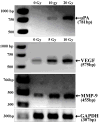Response of neuroblastoma cells to ionizing radiation: modulation of in vitro invasiveness and angiogenesis of human microvascular endothelial cells
- PMID: 17088992
- PMCID: PMC2441915
Response of neuroblastoma cells to ionizing radiation: modulation of in vitro invasiveness and angiogenesis of human microvascular endothelial cells
Abstract
Neuroblastomas are the most common extra-cranial tumors of childhood and well known for their heterogeneous clinical behavior associated with certain genetic aberrations. Radiation therapy is an important modality for the treatment of high-risk neuroblastomas. In this study, we investigated whether ionizing irradiation modulate the migration and invasiveness of human neuroblastoma cells and expression of proangiogenic molecules known to be involved in tumor progression and metastasis. Irradiation of neuroblastoma cells resulted in increased migration and invasion as measured by spheroid migration and matrigel invasion assay respectively. Zymographic analysis revealed an increase in enzyme activity of MMP-9 and uPA in conditioned medium of irradiated neuroblastoma cells compared with non-irradiated cells. An increase in VEGF levels was also found in lysates of irradiated neuroblastoma cells. The up-regulation of uPA, MMP-9 and VEGF transcripts was also confirmed by RT-PCR analysis. Next, we examined the irradiated tumor cell-mediated modulation of endothelial cell behavior. Conditioned media from irradiated neuroblastoma cells enhanced capillary-like structure formation of microvascular endothelial cells. In a coculture system, irradiation of neuroblastoma cells enhanced endothelial cell invasiveness through Matrigel matrix. Endothelial cells treated with irradiated tumor cell conditioned medium were also analyzed for expression of uPA, MMP-9 and VEGF and compared to cells treated with non-irradiated tumor cell conditioned medium. These findings suggest that the irradiation effects of tumor cells could influence endothelial angiogenesis present in non-irradiated fields.
Figures







Similar articles
-
Angiogenesis and tumor growth inhibition by a matrix metalloproteinase inhibitor targeting radiation-induced invasion.Mol Cancer Ther. 2005 Nov;4(11):1717-28. doi: 10.1158/1535-7163.MCT-05-0179. Mol Cancer Ther. 2005. PMID: 16275993
-
Inhibition of angiogenesis and invasion by 3,3'-diindolylmethane is mediated by the nuclear factor-kappaB downstream target genes MMP-9 and uPA that regulated bioavailability of vascular endothelial growth factor in prostate cancer.Cancer Res. 2007 Apr 1;67(7):3310-9. doi: 10.1158/0008-5472.CAN-06-4277. Cancer Res. 2007. Retraction in: Cancer Res. 2018 Sep 15;78(18):5471. doi: 10.1158/0008-5472.CAN-18-1170. PMID: 17409440 Retracted.
-
Carbon ion radiation inhibits glioma and endothelial cell migration induced by secreted VEGF.PLoS One. 2014 Jun 3;9(6):e98448. doi: 10.1371/journal.pone.0098448. eCollection 2014. PLoS One. 2014. PMID: 24893038 Free PMC article.
-
Inhibition and mechanism of action of a protease inhibitor in human pancreatic cancer cells.Pancreas. 2004 Aug;29(2):123-31. doi: 10.1097/00006676-200408000-00007. Pancreas. 2004. PMID: 15257104
-
Angiogenesis in neuroblastoma.Ann N Y Acad Sci. 2004 Dec;1028:133-42. doi: 10.1196/annals.1322.014. Ann N Y Acad Sci. 2004. PMID: 15650239 Review.
Cited by
-
Radioprotective effect of Date syrup on radiation- induced damage in Rats.Sci Rep. 2018 May 9;8(1):7423. doi: 10.1038/s41598-018-25586-3. Sci Rep. 2018. PMID: 29743497 Free PMC article.
-
Radiation oncology in vitro: trends to improve radiotherapy through molecular targets.Biomed Res Int. 2014;2014:461687. doi: 10.1155/2014/461687. Epub 2014 Sep 15. Biomed Res Int. 2014. PMID: 25302298 Free PMC article. Review.
-
LINC00152 is a potential biomarker involved in the modulation of biological characteristics of residual colorectal cancer cells following chemoradiotherapy.Oncol Lett. 2018 Apr;15(4):4177-4184. doi: 10.3892/ol.2018.7833. Epub 2018 Jan 22. Oncol Lett. 2018. PMID: 29541183 Free PMC article.
-
Radiation modulates expression and related activities of c-Met protein in oral tongue squamous cell carcinoma cell lines.J Cancer Res Clin Oncol. 2023 Jul;149(8):4173-4184. doi: 10.1007/s00432-022-04307-4. Epub 2022 Sep 2. J Cancer Res Clin Oncol. 2023. PMID: 36053327 Free PMC article.
-
Suppression of uPA and uPAR blocks radiation-induced MCP-1 mediated recruitment of endothelial cells in meningioma.Cell Signal. 2011 Aug;23(8):1299-310. doi: 10.1016/j.cellsig.2011.03.011. Epub 2011 Mar 21. Cell Signal. 2011. PMID: 21426933 Free PMC article.
References
-
- Maris JM, Matthay KK. Molecular biology of neuroblastoma. J Clin Oncol. 1999;17:2264–2279. - PubMed
-
- Escobar MA, Grosfeld JL, Powell RL, West KW, Scherer LR, 3rd, Fallon RJ, Rescorla FJ. Long-term outcomes in patients with stage IV neuroblastoma. J Pediatr Surg. 2006;41:377–381. - PubMed
-
- Schmidt ML, Lukens JN, Seeger RC, Brodeur GM, Shimada H, Gerbing RB, Stram DO, Perez C, Haase GM, Matthay KK. Biologic factors determine prognosis in infants with stage IV neuroblastoma: A prospective Children's Cancer Group study. J Clin Oncol. 2000;18:1260–1268. - PubMed
-
- Laprie A, Michon J, Hartmann O, Munzer C, Leclair MD, Coze C, Valteau-Couanet D, Plantaz D, Carrie C, Habrand JL, Bergeron C, Chastagner P, Defachelles AS, Delattre O, Combaret V, Benard J, Perel Y, Gandemer V, Rubie H. Neuroblastoma Study Group of the French Society of Pediatric Oncology. High-dose chemotherapy followed by locoregional irradiation improves the outcome of patients with international neuroblastoma staging system Stage II and III neuroblastoma with MYCN amplification. Cancer. 2004;101:1081–1089. - PubMed
-
- Escobar MA, Grosfeld JL, Powell RL, West KW, Scherer LR, 3rd, Fallon RJ, Rescorla FJ. Long-term outcomes in patients with stage IV neuroblastoma. J Pediatr Surg. 2006;41:377–381. - PubMed
Publication types
MeSH terms
Substances
Grants and funding
LinkOut - more resources
Full Text Sources
Medical
Miscellaneous

